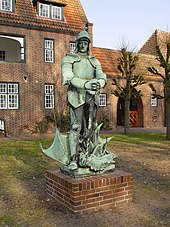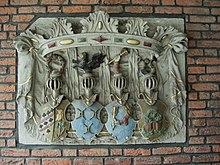St. Michaelis (Bremen)
The St. Michaelis Church is a Protestant church in the Bahnhofsvorstadt district of Bremen . It was named after the Archangel Michael .
history
The existing church has several predecessors of the same name.
10/11 Century at the cathedral
Under Archbishop Adalgar , a chapel was built east of the cathedral, which was dedicated to Saints Stephen and Vitus and the Archangel Michael . In this church were from the diocese of Bremen archbishops Rimbert († 888), Adalgar († 909), Hoger buried († 915) and Reginward († 918). This church was demolished in 1035.
1194–1524 in front of the Ansgaritor
The next Michaeliskirche was in front of the Ansgaritor. It was mentioned as a chapel in 1194/98 after apparently a long existence, in a contract with a nunnery that had used it, but had since moved to Bergedorf near Ganderkesee. Later it was under the Ansgarii Chapter . From about 1330 it served as a parish church. From 1343 to 1530 rectors are mentioned repeatedly , later then outstanding income for 1524. Its demolition in 1524 amounted to vandalism, chroniclers write of "drunk citizens".
From 1524 in Walle
After the loss of the small church, the residents of Walle , who had previously attended the service there, were allowed to build a church of the same name in their village, for which they probably also took the stones of the suburban chapel. Hermann Ko (c) k is mentioned as the first (now Protestant) pastor there. The furnishings in Waller's Michaeliskirche came from the St. John's Chapel, which was torn down, and the St. Today the Waller Church no longer has a namesake.
The parish rights for the suburb in front of the Ansgaritor passed to the Stephanikapitel .
From 1697 in front of the Doventor
Baroque
From 1697 to 1700 a Michaeliskirche was built in the suburb, which was inaugurated on October 13th, 1700. She was at the crossroads where the path from Doventor met on the path that had previously led from Ansgaritor to the old chapel. The latter, however, had been given a detour through the wide ramparts with bastions . The new church served as the parish church of the western suburbs in front of the Stephaniviertel and was a simple hall building with a roof turret.
Neo-Gothic
A neo-Gothic brick church was built in its place from 1898 to 1900 , initiated by Pastor Otto Veeck and based on the plans of the imperial building officer Jürgen Kröger from Berlin. The church consecration took place on October 14, 1900. The single-nave cross-shaped central building had crossed gable roofs. The tower was on a corner. The interior was vaulted and there were galleries in the cross arms . The interior was of a high quality craftsmanship. In 1934 the Martin Luther congregation in the Findorff quarter was separated from the Michaeliskirch congregation . The fourth Michaelis church was in the Second World War seriously damaged in an air raid in 1943 and burned in the fire storm on the night of 18/19. August 1944. The ruins remained standing for a long time.

A neo-baroque bronze figure of the Archangel Michael, donated by the mayor Victor Marcus , created in Breslau by the sculptor Richard Grüttner , was at the church after 1900. It survived the war, was kept in a storage place and was supposed to be melted down. The Egyptian businessman Safwad Faltas acquired and restored it in 1974 and set it up on the protective dike in Warturm in Woltmershausen . The statue stands today in front of the Rosenhof of the Egestorff Foundation in Osterholz (see also: Statues of the City of Bremen ).
Modern
After 1944, the Michaelis parish was supplied by the Martin Luther parish , revived in 1960 and then independent in 1965. First the community had to reside in a makeshift church building. The fifth St. Michaelis Church was planned by the architects Jörg Blanckenhorn and Gottfried Müller, built in 1965/66 and inaugurated on November 27, 1966.
architecture
The church is a brick building and with its large roof made of two triangles looks like a tent. The roof ridge rises steeply and is surmounted by a globe and a seven-meter-high and one-tonne cross. The church interior is around 25 m high. The entire weight of the sweeping roof rests on the rising, 32 m long and 1.60 m high central beam. The walls are made of bricks. The colors of the glass blocks by the artist Heinz Lilienthal give the entrance room a light, relaxed atmosphere. The light strips made of colored concrete glass inside the church also come from Lilienthal.
The massive altar, as well as the entire design of the chancel, was designed by the Worpswede artist Ulrich Conrad. The cross, also designed by Conrad, hangs in the middle of the field of vision for every church visitor. The peculiarity of the cross: the crucified is not seen in conventional form on the cross, rather the artist has left out the silhouette of Jesus in the cross.
The pulpit is hardly raised. On the side of the pulpit there are bars, on the short bar there is an inscription: From Paul's letter to the Ephesians , chapter 2, it says: “Jesus Christ is our peace. He has come and has proclaimed peace as the good news, peace to those who are far away and peace to those who are near, because through him we both have access to the Father in one spirit ”. On the long grille you can see gulls pecking up freshly sown seeds, thorns that choke growing grain, too little arable tops that will soon wither the grain and you can see the full ears.
The organ by Rudolph Beckerath from Hamburg , a fully mechanical loop organ with 18 sounding voices in the main, chest and pedal parts, is located on the large choir empire .
In the entrance area, on the wall of the parish hall, there is the coat of arms of the Michaeliskirche from 1700, which has been a listed building since 1973 .
Parish
The parishes of St. Stephani (around 1050) and St. Michaelis (around 1330) go back to the Middle Ages. The theologian Otto Veeck had been with the church since 1890. From the parish of St. Michaelis the Martin Luther parish in the Findorffviertel emerged in 1934 , which was responsible for the parish of St. Michaelis from 1944 to 1960/65 due to the war.
Since January 1, 2009, the two formerly independent parishes of St. Michaelis and St. Stephani have merged to form the St. Michaelis - St. Stephani parish in Bremen .
Individual evidence
- ↑ Bremisches Urkundenbuch, Vol. I, p. 94/95, No. 82 (c. 1194–1198)
- ↑ In memory of the six hundred year jubilee of the St. Ansgariikirche in 1843, p. 44f. (Google digitized version)
- ↑ Johann Hermnann Duntze, history of the free city of Bremen (1845), Vol 1, p 200. The other Michelis-Capelle (BUB - Digital Collections)
- ↑ Bremisches Jahrbuch ›Volume 60/61 (1982/1983)› De Kercke Sunte Michaelis tho Walle. Notes on the history of the church in Bremen ...
- ^ Monument database of the LfD
literature
- Church leader St. Michaelis Bremen
- Herbert Black Forest : The Great Bremen Lexicon . 2nd, updated, revised and expanded edition. Edition Temmen , Bremen 2003, ISBN 3-86108-693-X .
Web links
Coordinates: 53 ° 5 ′ 8.4 " N , 8 ° 47 ′ 56.9" E


